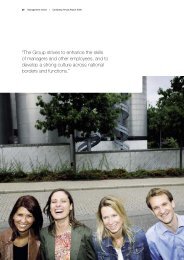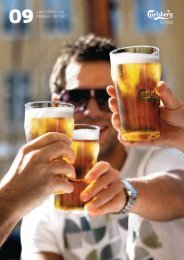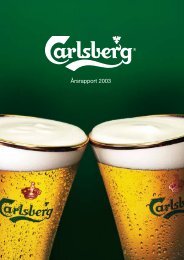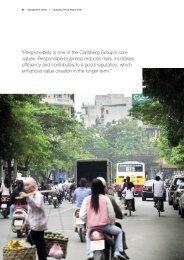Download: In the footprints of Carlsberg's founders - Carlsberg Group
Download: In the footprints of Carlsberg's founders - Carlsberg Group
Download: In the footprints of Carlsberg's founders - Carlsberg Group
You also want an ePaper? Increase the reach of your titles
YUMPU automatically turns print PDFs into web optimized ePapers that Google loves.
<strong>In</strong> <strong>the</strong> Footprints <strong>of</strong> <strong><strong>Carlsberg</strong>'s</strong> <strong>founders</strong><br />
The Jacobsen family's impact on <strong>the</strong> architecture <strong>of</strong> Copenhagen & Valby<br />
J.C. Jacobsen (1811–1887) and his son Carl Jacobsen (1842–1914) founded one <strong>of</strong><br />
<strong>the</strong> largest brewery groups in <strong>the</strong> world, <strong>the</strong> <strong>Carlsberg</strong> <strong>Group</strong>. But <strong>the</strong>y made an<br />
immense contribution to <strong>the</strong> architecture and cultural life <strong>of</strong> <strong>the</strong> Danish capital,<br />
Copenhagen.<br />
"Let <strong>the</strong> art ennoble our city, so that it may ennoble our lives” said Carl Jacobsen.<br />
THE LITTLE MERMAID<br />
The famous sculpture <strong>of</strong> The Little Mermaid at<br />
Langelinie quay was donated to <strong>the</strong> city <strong>of</strong><br />
Copenhagen by Carl Jacobsen in 1913. Carl loved<br />
<strong>the</strong> ballet and <strong>of</strong>ten visited <strong>the</strong> Royal Theatre.<br />
<strong>In</strong>fatuated by <strong>the</strong> ballet The Little Mermaid, and by<br />
<strong>the</strong> dancer Ellen Price de Plane who starred in <strong>the</strong><br />
title role, he asked <strong>the</strong> artist Edvard Eriksen to<br />
create a sculpture that could capture her graceful<br />
figure. Eriksen took on <strong>the</strong> job and sculpted <strong>the</strong><br />
mermaid using his wife, Eline Eriksen, as model.<br />
Today The Little Mermaid is one <strong>of</strong> <strong>the</strong> most visited<br />
tourist attractions in Denmark.<br />
Carl Jacobsen also financed <strong>the</strong> Huitfeldt Column on <strong>the</strong> Langelinie quay.<br />
Location:<br />
The Langelinie quay<br />
Artist:<br />
Edvard Eriksen<br />
Erected:<br />
1913<br />
1
<strong>In</strong> <strong>the</strong> Footprints <strong>of</strong> <strong><strong>Carlsberg</strong>'s</strong> <strong>founders</strong><br />
THE GEFION FOUNTAIN<br />
The Gefion Fountain, which was created by Anders Bundgaard in 1907, was erected in<br />
celebration <strong>of</strong> <strong>Carlsberg</strong>’s 50 th birthday. It was financed partly by <strong>the</strong> <strong>Carlsberg</strong><br />
Foundation and partly by <strong>the</strong> Copenhagen municipal art foundation.<br />
According to myth, <strong>the</strong> Swedish king Gylfe <strong>of</strong>fered <strong>the</strong> goddess Gefion as much <strong>of</strong> his<br />
country as she could plough in one night. She transformed her four sons into oxen<br />
and ploughed so deep that <strong>the</strong>y were able to lift up <strong>the</strong> land and draw it into <strong>the</strong><br />
ocean, creating <strong>the</strong> island <strong>of</strong> Zealand. The legend says that <strong>the</strong> hole <strong>the</strong>y created in<br />
Sweden is now <strong>the</strong> lake Vänern.<br />
Location:<br />
The Langelinie Quay<br />
Artist:<br />
Anders Bundgaard<br />
Erected:<br />
1908<br />
2
<strong>In</strong> <strong>the</strong> Footprints <strong>of</strong> <strong><strong>Carlsberg</strong>'s</strong> <strong>founders</strong><br />
THE ROYAL DANISH CAST COLLECTION<br />
The Vestindisk Pakhus in Toldbodgade, near <strong>the</strong> Royal<br />
Palace <strong>of</strong> Amalienborg, is home to a magnificent<br />
collection <strong>of</strong> plaster casts taken from statues and reliefs<br />
in museums, temples, churches and public places around<br />
<strong>the</strong> world.<br />
There are casts <strong>of</strong> sculptures dating from antiquity<br />
through to <strong>the</strong> Renaissance, including Egyptian Kings and<br />
mythical beasts, Greek gods and human beings, Roman<br />
Emperors and scenes <strong>of</strong> battle and sacrifice. While Carl<br />
Jacobsen was <strong>the</strong> director <strong>of</strong> <strong>the</strong> museum, he, and <strong>the</strong><br />
New <strong>Carlsberg</strong> Foundation, increased <strong>the</strong> collection by<br />
almost 1,000 casts.<br />
Location:<br />
Vestindisk Pakhus<br />
Toldbodgade 40<br />
1253 København K<br />
Website:<br />
www.smk.dk<br />
3
<strong>In</strong> <strong>the</strong> Footprints <strong>of</strong> <strong><strong>Carlsberg</strong>'s</strong> <strong>founders</strong><br />
BOTANIC GARDEN<br />
JC Jacobsen was a member <strong>of</strong> <strong>the</strong> building committee <strong>of</strong><br />
<strong>the</strong> Botanical Gardens and contributed large sums <strong>of</strong><br />
money when <strong>the</strong> project ran short <strong>of</strong> funds in 1874. He<br />
also paid for construction <strong>of</strong> <strong>the</strong> heating system and<br />
influenced <strong>the</strong> design <strong>of</strong> <strong>the</strong> greenhouses. His son Carl<br />
donated many bronze statues, including PallasA<strong>the</strong>na,<br />
Artemis, <strong>the</strong> Discus Thrower, Amazon, A<strong>the</strong>na and Myron,<br />
Narcissus and <strong>the</strong> Sandal Tier, which all contribute to<br />
Gardens’ mythical <strong>the</strong>me.<br />
Location:<br />
Go<strong>the</strong>rsgade 128<br />
1123 Copenhagen K.<br />
Website:<br />
http://botanik.snm.ku.dk/english/<br />
4
<strong>In</strong> <strong>the</strong> Footprints <strong>of</strong> <strong><strong>Carlsberg</strong>'s</strong> <strong>founders</strong><br />
THE STORK FOUNTAIN<br />
Carl Jacobsen was a co-founder <strong>of</strong> <strong>the</strong> Association for <strong>the</strong><br />
Beautification <strong>of</strong> <strong>the</strong> Capital. The Stork Fountain, designed<br />
by Vilhelm Bissen and Edvard Petersen, was <strong>the</strong> winner <strong>of</strong><br />
a competition run and funded by <strong>the</strong> Association in<br />
1894. Its reward was a very prominent position on<br />
Amager Torv in <strong>the</strong> centre <strong>of</strong> Copenhagen.<br />
Location:<br />
Amagertorv<br />
Architects:<br />
Vilhelm Bissen & Edvard Petersen<br />
Built:<br />
1894<br />
5
<strong>In</strong> <strong>the</strong> Footprints <strong>of</strong> <strong><strong>Carlsberg</strong>'s</strong> <strong>founders</strong><br />
STEEPLE OF NIKOLAJ CHURCH<br />
"The City <strong>of</strong> beautiful towers", is what Carl Jacobsen called his home town <strong>of</strong><br />
Copenhagen. And he donated one <strong>of</strong> <strong>the</strong> most beautiful examples - <strong>the</strong> steeple <strong>of</strong> Sct<br />
Nikolaj Church.<br />
The ancient Sct Nikolaj Church was almost burned<br />
to <strong>the</strong> ground in 1795. The main building was torn<br />
down and only <strong>the</strong> solid tower remained. When <strong>the</strong><br />
church was rebuilt, it was too costly to replace <strong>the</strong><br />
steeple, so Carl Jacobsen financed its reconstruction<br />
in 1911.<br />
Today, Sct Nikolaj Church is no longer used as a<br />
church but primarily hosts exhibitions <strong>of</strong><br />
contemporary art.<br />
Location:<br />
Nikolaj Plads<br />
1067 Copenhagen K.<br />
Built:<br />
12th century – rebuilt in <strong>the</strong> 18th century<br />
6
<strong>In</strong> <strong>the</strong> Footprints <strong>of</strong> <strong><strong>Carlsberg</strong>'s</strong> <strong>founders</strong><br />
LURE PLAYERS AT CITY HALL SQUARE<br />
The bronze statues <strong>of</strong> <strong>the</strong> lure players were donated by <strong>the</strong> <strong>Carlsberg</strong> Foundation and<br />
New <strong>Carlsberg</strong> Foundation in1911 to commemorate JC Jacobsen’s 100th birthday.<br />
They stand on a high column in City Hall Square and, according to folklore, blow <strong>the</strong>ir<br />
horns if a virgin walks by.<br />
Location:<br />
Rådhuspladsen<br />
1599 Copenhagen V.<br />
Artists:<br />
Siegfried Wagner and Anton Rosen.<br />
Built:<br />
1911<br />
7
<strong>In</strong> <strong>the</strong> Footprints <strong>of</strong> <strong><strong>Carlsberg</strong>'s</strong> <strong>founders</strong><br />
THE HUITFELDT COLUMN<br />
Ivar Hui<strong>the</strong>ldt was a Danish captain who died fighting courageously against <strong>the</strong><br />
Swedes during <strong>the</strong> battle <strong>of</strong> Køge bay in 1710. His memorial on <strong>the</strong> Langelinie quay is<br />
decorated with <strong>the</strong> cannons and <strong>the</strong> anchor from his ship, <strong>the</strong> 'Dannebrog', which is<br />
also <strong>the</strong> name <strong>of</strong> <strong>the</strong> Danish flag. Carl Jacobsen was <strong>the</strong> main contributor to <strong>the</strong><br />
monument.<br />
Location:<br />
The Langelinie quay<br />
Artist:<br />
Ferdinand Edvard Ring and Vilhelm Dahlerup<br />
Erected:<br />
1886<br />
8
<strong>In</strong> <strong>the</strong> Footprints <strong>of</strong> <strong><strong>Carlsberg</strong>'s</strong> <strong>founders</strong><br />
NY CARLSBERG GLYPTOKET<br />
The Ny <strong>Carlsberg</strong> Glyptotek was founded by Carl Jacobsen<br />
<strong>of</strong> <strong>the</strong> Ny <strong>Carlsberg</strong> Brewery, who donated his personal art<br />
collections to <strong>the</strong> public in <strong>the</strong> late 1800s. The Danish State<br />
and <strong>the</strong> City <strong>of</strong> Copenhagen financed <strong>the</strong> construction <strong>of</strong> <strong>the</strong><br />
museum, which was designed by architects Vilhelm Dahlerup<br />
and Hack Kampmann.<br />
The Ny <strong>Carlsberg</strong> Glyptotek was completed in 1906 and has<br />
become a museum <strong>of</strong> international stature. It houses more<br />
than 10,000 works <strong>of</strong> art in two principal collections – one<br />
comprising ancient art from <strong>the</strong> Mediterranean cradle <strong>of</strong> Western culture, and <strong>the</strong><br />
o<strong>the</strong>r Danish and French art from <strong>the</strong> 19th and 20th centuries.<br />
Location:<br />
Dantes Plads 7<br />
1556 Copenhagen V.<br />
Architects:<br />
Vilhelm Dahlerup (1897),<br />
Hack Kampmann (1906) &<br />
Henning Larsen (1996).<br />
Built:<br />
1897 - expanded in 1906 and 1996<br />
Website:<br />
www.glyptoteket.dk<br />
9
<strong>In</strong> <strong>the</strong> Footprints <strong>of</strong> <strong><strong>Carlsberg</strong>'s</strong> <strong>founders</strong><br />
THE DANISH MUSEUM OF ART AND DESIGN<br />
The Danish Museum <strong>of</strong> Art & Design was founded in 1890<br />
by <strong>the</strong> <strong>In</strong>dustrial Society <strong>of</strong> Copenhagen (now Dansk<br />
<strong>In</strong>dustri – The Confederation <strong>of</strong> Danish <strong>In</strong>dustries) and <strong>the</strong><br />
Ny <strong>Carlsberg</strong> Museumslegat. The Ny <strong>Carlsberg</strong> Foundation<br />
has made donations to <strong>the</strong> museum throughout <strong>the</strong> last<br />
century.<br />
Location:<br />
Bredgade 68<br />
1260 København K<br />
Built:<br />
1890<br />
Website:<br />
www.kunstindustrimuseet.dk<br />
10
<strong>In</strong> <strong>the</strong> Footprints <strong>of</strong> <strong><strong>Carlsberg</strong>'s</strong> <strong>founders</strong><br />
STATUES IN H. C. ØRSTED'S PARK<br />
Many <strong>of</strong> <strong>the</strong> statues in HC Ørsted's Park were donated by<br />
<strong>Carlsberg</strong> through <strong>the</strong> Albertina grant. This grant was set up<br />
by Carl Jacobsen to purchase artworks for <strong>the</strong> public squares<br />
and parks <strong>of</strong> Copenhagen. Carl believed that making<br />
Copenhagen more beautiful would increase <strong>the</strong> citizens' love<br />
for <strong>the</strong>ir home city.<br />
Amongst o<strong>the</strong>rs, <strong>the</strong> Albertina grant funded The Dying Gaul,<br />
Silen with Bacchus child, Satyr with Bacchus Child, <strong>the</strong><br />
Sharpener, Resting Hermes, <strong>the</strong> Lizard Killer, Resting Satyr,<br />
Chapu: Jeanne D’Arc in Domrémy, Flute-playing Satyr boy,<br />
The Wrestlers and <strong>the</strong> Wine-sucking Satyr boy.<br />
Location:<br />
Between Nørre Voldgade and Nørre Farimagsgade<br />
11
<strong>In</strong> <strong>the</strong> Footprints <strong>of</strong> <strong><strong>Carlsberg</strong>'s</strong> <strong>founders</strong><br />
CHURCH OF JESUS<br />
<strong>In</strong> planning <strong>the</strong> Church <strong>of</strong> Jesus, Carl Jacobsen wanted to<br />
build <strong>the</strong> most beautiful church in Copenhagen. He<br />
employed <strong>the</strong> renowned Danish architect Vilhelm<br />
Dahlerup, who designed a classic early church with a<br />
basilica and campanile (detached bell-tower).<br />
The Jacobsen family are buried in <strong>the</strong> crypts <strong>of</strong> <strong>the</strong><br />
Church <strong>of</strong> Jesus, which is situated very close to <strong>the</strong><br />
<strong>Carlsberg</strong> Brewery. The four bells in <strong>the</strong> church tower<br />
bear witness to a family tragedy, as <strong>the</strong>y are each named<br />
after one <strong>of</strong> Carl’s four children who died in infancy - Alf,<br />
Beatrice, Thorvald and Erland.<br />
Location:<br />
Kirkevænget<br />
2500 Valby<br />
Architects:<br />
Vilhelm Dahlerup<br />
Built:<br />
1891<br />
12
<strong>In</strong> <strong>the</strong> Footprints <strong>of</strong> <strong><strong>Carlsberg</strong>'s</strong> <strong>founders</strong><br />
THE OLD BREWERY<br />
The Old Brewery, where JC Jacobsen founded <strong>Carlsberg</strong>, was constructed in<br />
collaboration with <strong>the</strong> architect HC Stilling. Opened in 1847, it comprised a brew<br />
house, a storehouse and a half-timbered stable block. JC Jacobsen named <strong>the</strong><br />
brewery “<strong>Carlsberg</strong>” after his son Carl and <strong>the</strong> "berg" (Danish for "hill") on which it<br />
was built.<br />
Various extensions were added up until 1867, when <strong>the</strong> brewery and <strong>the</strong> granary<br />
burnt down. The whole complex was rebuilt <strong>the</strong> same year, this time using iron in <strong>the</strong><br />
supporting structures.<br />
The buildings and industrial plant were renovated in 1982 and <strong>the</strong> brewery was<br />
opened to <strong>the</strong> public. <strong>In</strong> 1999, <strong>the</strong> site became part <strong>of</strong> <strong>the</strong> <strong>Carlsberg</strong> Visitors Centre.<br />
More at www.visitcarlsberg.com.<br />
Location:<br />
Gl. <strong>Carlsberg</strong> Vej<br />
Architects:<br />
J.C. Jacobsen/H.C. Stilling<br />
Built:<br />
1847/1878<br />
13
<strong>In</strong> <strong>the</strong> Footprints <strong>of</strong> <strong><strong>Carlsberg</strong>'s</strong> <strong>founders</strong><br />
THE CARLSBERG LABORATORY<br />
The <strong>Carlsberg</strong> Laboratory was established in 1875. Its purpose was to increase <strong>the</strong><br />
scientific understanding <strong>of</strong> <strong>the</strong> malting, brewing and fermenting processes, and it has<br />
been responsible for several groundbreaking scientific discoveries, including <strong>the</strong> pH<br />
scale.<br />
<strong>In</strong> 1884, JC Jacobsen gave <strong>the</strong> estate on Gl. <strong>Carlsberg</strong> Vej 10 to <strong>the</strong> Laboratory and<br />
financed <strong>the</strong> construction <strong>of</strong> its new building, designed by architect FC Thomsen in <strong>the</strong><br />
Italian renaissance style. The <strong>Carlsberg</strong> Laboratory was opened on 10 November<br />
1897– <strong>the</strong> brewery’s 50th birthday. The statue <strong>of</strong> JC Jacobsen in front <strong>of</strong> <strong>the</strong><br />
Laboratory was unveiled at <strong>the</strong> same time.<br />
The building currently houses <strong>the</strong> <strong>Carlsberg</strong> Laboratory's chemistry department.<br />
More at www.carlsberglab.dk<br />
Location:<br />
Gl. <strong>Carlsberg</strong> Vej 10<br />
Architect:<br />
F.C. Thomsen<br />
Built:<br />
1893-96<br />
14
<strong>In</strong> <strong>the</strong> Footprints <strong>of</strong> <strong><strong>Carlsberg</strong>'s</strong> <strong>founders</strong><br />
NEW CARLSBERG MAIN BUILDING<br />
The original main building <strong>of</strong> <strong>the</strong> Bakkegården property was Carl and Ottilia Jacobsen’s<br />
home from 1880 to 1890. When <strong>the</strong> couple lost four children to childhood diseases<br />
between 1887 and 1890, <strong>the</strong> building was deemed to be unhealthy and was<br />
demolished. A villa designed by Hack Kampmann’s was erected in its place.<br />
Following Carl Jacobsen’s death in 1914, his descendants lived in <strong>the</strong> villa up to<br />
1998. The house was since been renovated, and <strong>the</strong> walls and ceilings have been<br />
restored to <strong>the</strong>ir original appearance.<br />
The building has extensive ornamentation including <strong>the</strong> swastika, which was<br />
registered as <strong>the</strong> trademark <strong>of</strong> New <strong>Carlsberg</strong> in 1881. Carl Jacobsen chose <strong>the</strong><br />
historic symbol as a result <strong>of</strong> his interest in Ancient Rome and Greece.<br />
Location:<br />
Ny <strong>Carlsberg</strong> Vej<br />
Architect:<br />
Hack Kampmann<br />
Built:<br />
1891-92<br />
15
<strong>In</strong> <strong>the</strong> Footprints <strong>of</strong> <strong><strong>Carlsberg</strong>'s</strong> <strong>founders</strong><br />
THE CARLSBERG MUSEUM<br />
<strong>In</strong> 1882 Carl Jacobsen opened <strong>the</strong> <strong>Carlsberg</strong> Museum, containing his collection <strong>of</strong> fine<br />
arts, to <strong>the</strong> public. This created <strong>the</strong> foundation for what would later become <strong>the</strong> New<br />
<strong>Carlsberg</strong> Glyptotek.<br />
Carl called <strong>the</strong> collection "Glyptotek" to signify that it was not a museum, where <strong>the</strong><br />
antique figures should be regarded from an historical viewpoint, but ra<strong>the</strong>r a place<br />
where <strong>the</strong>y should live in <strong>the</strong>ir own beauty.<br />
The collections quickly grew and by 1895 a total <strong>of</strong> 19 rooms had been constructed for<br />
<strong>the</strong> museum. Vilhelm Dahlerup built <strong>the</strong> first 14 rooms up to 1893, while <strong>the</strong> later<br />
additions were built by Hack Kampmann, who also rebuilt <strong>the</strong> original winter garden.<br />
The collection moved to <strong>the</strong> Ny <strong>Carlsberg</strong> Glyptotek in two stages - <strong>the</strong> modern<br />
collection in 1896 and <strong>the</strong> antique collection in 1906.<br />
<strong>In</strong> 1915, Carl’s son, Vagn, established <strong>the</strong> <strong>Carlsberg</strong> Museum to tell <strong>the</strong> story <strong>of</strong> <strong>the</strong><br />
Jacobsen family and <strong>the</strong> <strong>Carlsberg</strong> Foundation.<br />
Location:<br />
Valby Langgade 1<br />
2500 Valby<br />
Architects:<br />
Vilhelm Dahlerup/Hack Kampmann<br />
Built:<br />
1882-95<br />
16
<strong>In</strong> <strong>the</strong> Footprints <strong>of</strong> <strong><strong>Carlsberg</strong>'s</strong> <strong>founders</strong><br />
THE DIPYLON GATE<br />
The Dipylon Gate serves as <strong>the</strong> entrance to <strong>the</strong> New <strong>Carlsberg</strong> Brewery from <strong>the</strong><br />
Vesterbro side.<br />
The Dipylon originally housed two malting floors and malt was loaded in and out <strong>of</strong><br />
carriages through tubes in <strong>the</strong> gate ceiling. It also has a bell tower featuring Stephen<br />
Sinding’s artwork The Bell Strikers.<br />
The gate is inscribed with <strong>the</strong> “Golden Words", first used by JC Jacobsen in his will,<br />
but later adopted by Carl Jacobsen.<br />
“<strong>In</strong> working <strong>the</strong> brewery it should be a constant purpose, regardless <strong>of</strong> immediate<br />
gain, to develop <strong>the</strong> art <strong>of</strong> making beer to <strong>the</strong> greatest possible degree <strong>of</strong> perfection<br />
so that this brewery as well as its products may ever stand out as a model and,<br />
through <strong>the</strong>ir example, assist in keeping beer brewing in this country at a high and<br />
honourable level”.<br />
<strong>Carlsberg</strong>’s beer is still brewed according to <strong>the</strong>se principles.<br />
The tile paintings on <strong>the</strong> reverse <strong>of</strong> <strong>the</strong> gate depict nine<br />
figures: owner and brewer Carl Jacobsen, his wife Ottilia,<br />
and his son Alf (who was <strong>the</strong> chosen heir but who died in<br />
1890); Carl’s closest collaborators in building <strong>the</strong><br />
brewery - architect Vilhelm Dahlerup and master builder<br />
SP Beckmann; and, representing <strong>the</strong> brewery’s<br />
employees, <strong>of</strong>fice manager Chr Grønlund, pr<strong>of</strong>essor R<br />
Hesberg, chief inspector V Henningsen, and an ordinary<br />
brewery worker.<br />
Location:<br />
Ny <strong>Carlsberg</strong> Vej (eastern entrance)<br />
Architect:<br />
Vilhelm Dahlerup<br />
Built:<br />
1892<br />
17
<strong>In</strong> <strong>the</strong> Footprints <strong>of</strong> <strong><strong>Carlsberg</strong>'s</strong> <strong>founders</strong><br />
THE BREW HOUSE<br />
The Brew House is a prime example <strong>of</strong> Carl Jacobsen's desire to create an<br />
extraordinarily beautiful working environment at <strong>Carlsberg</strong>. It dates from 1901 when<br />
it replaced a smaller brew house, which can still be seen on <strong>the</strong> opposite side <strong>of</strong> <strong>the</strong><br />
road.<br />
The building's facade has a balcony modelled to resemble those in <strong>the</strong> Palazzo<br />
Bavilaque in Verona. On <strong>the</strong> ro<strong>of</strong> is a large copper sculpture by CJ Bonnesen entitled<br />
“Thor’s battle against <strong>the</strong> giants”. The group <strong>of</strong> figures was actually a competition<br />
proposal for <strong>the</strong> fountain at Langelinie, which was won by Anders Bundgaard’s Gefion<br />
group. Carl subsequently asked Bonnesen to produce a copy for <strong>the</strong> Brew House.<br />
Location:<br />
Ny <strong>Carlsberg</strong> Vej<br />
Architects:<br />
Vilhelm Klein/Carl Harild<br />
Built:<br />
1901/1920<br />
18
<strong>In</strong> <strong>the</strong> Footprints <strong>of</strong> <strong><strong>Carlsberg</strong>'s</strong> <strong>founders</strong><br />
THE WINDING CHIMNEY<br />
Carl Jacobsen wanted to show that a chimney for an industrial plant could be beautiful<br />
in its own right, so he brought in architect Vilhelm Dahlerup and master builder PS<br />
Beckmann. Their 56m tall winding chimney features motifs <strong>of</strong> Egyptian lotus flowers<br />
while, on <strong>the</strong> plinth, replicas <strong>of</strong> <strong>the</strong> Chimeras (Gargoyles) from Notre Dame in Paris<br />
look out over <strong>the</strong> city <strong>of</strong> Copenhagen.<br />
This unique chimney is no longer in use, as it was replaced by a 100m tall chimney in<br />
1980.<br />
Location:<br />
By <strong>the</strong> Boiler House<br />
Architects:<br />
Carl Jacobsen & Vilhelm Dahlerup<br />
Built:<br />
1900<br />
19
<strong>In</strong> <strong>the</strong> Footprints <strong>of</strong> <strong><strong>Carlsberg</strong>'s</strong> <strong>founders</strong><br />
THE LIGHT HOUSE AND THE STAR GATE<br />
The Lighthouse and <strong>the</strong> Star Gate were built in 1883<br />
and marked <strong>the</strong> main entrance to Old <strong>Carlsberg</strong> on<br />
Pasteursvej.<br />
When electric lights were introduced in <strong>the</strong> brewery in<br />
1882, electricity was not widely available in<br />
Copenhagen. As <strong>the</strong> tower had easy access to<br />
sufficient power, it came to be used as a Lighthouse.<br />
The Gate is named after <strong>the</strong> twelve-pointed star which<br />
was Old <strong>Carlsberg</strong>’s original trademark. It was<br />
registered by JC Jacobsen in 1881 in <strong>the</strong> newly<br />
established trademark register.<br />
The dates inscribed on <strong>the</strong> pillars commemorate <strong>the</strong><br />
years 1847 – <strong>the</strong> first brew, 1867 – when Old <strong>Carlsberg</strong><br />
burned down, 1870 – <strong>the</strong> building <strong>of</strong> <strong>the</strong> Annex Brewery,<br />
and 1883 – <strong>the</strong> building <strong>of</strong> <strong>the</strong> Gate.<br />
Location:<br />
Pasteursvej<br />
Architect:<br />
P.C. Bønecke<br />
Built:<br />
1883<br />
20
<strong>In</strong> <strong>the</strong> Footprints <strong>of</strong> <strong><strong>Carlsberg</strong>'s</strong> <strong>founders</strong><br />
THE CARLSBERG ACADEMY<br />
<strong>In</strong> his Will, JC Jacobsen stated that, after he and his immediate family had passed<br />
away, his house should be used as an honorary residence for a deserving man or<br />
woman within <strong>the</strong> fields <strong>of</strong> science, literature or art.<br />
Since <strong>the</strong>n, <strong>the</strong> house has been home to many famous guests, including Albert<br />
Einstein. Its first resident was <strong>the</strong> philosopher Harald Høffding. He was followed by<br />
<strong>the</strong> atomic physicist Niels Bohr, who lived here from 1931 to 1962.<br />
The last resident was sinologist Søren Egerod. When he left <strong>the</strong> house in 1995, <strong>the</strong><br />
<strong>Carlsberg</strong> Foundation decided to convert <strong>the</strong> house into <strong>the</strong> <strong>Carlsberg</strong> Academy.<br />
The house is built in <strong>the</strong> classical Italian villa style and JC Jacobsen himself designed<br />
its heating/ventilation system. The English-inspired park dates from 1848 and was<br />
planned by landscape gardener Rudolph Ro<strong>the</strong> in accordance with JC Jacobsen’s ideas.<br />
It includes many rare plants and trees which JC Jacobsen brought back from his<br />
foreign trips.<br />
Location:<br />
Gl. <strong>Carlsberg</strong> Vej<br />
Architects:<br />
J.C. Jacobsen/N.S. Nebelong/P.C. Bønecke<br />
Built:<br />
1853<br />
21
<strong>In</strong> <strong>the</strong> Footprints <strong>of</strong> <strong><strong>Carlsberg</strong>'s</strong> <strong>founders</strong><br />
THE ELEPHANT TOWER<br />
The Elephant Tower is <strong>the</strong> most famous building on <strong>the</strong> <strong>Carlsberg</strong> Brewery site. It is<br />
especially known for its gate, where visitors are greeted by four life size elephants.<br />
The initial idea for <strong>the</strong> tower came from Carl Jacobsen, working in close collaboration<br />
with Vilhelm Dahlerup. It was inspired by Bernini’s obelisk-carrying elephant in <strong>the</strong><br />
Minerva Square in Rome and by <strong>the</strong> organ façade in Our Saviour's Church. The<br />
elephant is a symbol <strong>of</strong> loyalty and strength and characterises Carl Jacobsen’s Latin<br />
motto "Laboremus pro patria" - We work for our country.<br />
The elephants' blankets bear New <strong><strong>Carlsberg</strong>'s</strong> swastika trademark and <strong>the</strong> initials <strong>of</strong><br />
Carl’s four surviving children – Theodora, Vagn, Helge and Paula. The craftsmen and<br />
architect are commemorated on <strong>the</strong> inside <strong>of</strong> <strong>the</strong> gate.<br />
Location:<br />
Ny <strong>Carlsberg</strong> Vej<br />
Architect:<br />
Vilhelm Dahlerup<br />
Built:<br />
1901<br />
22



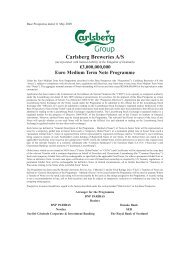
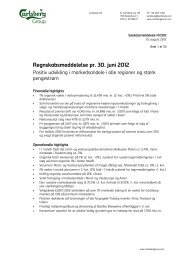

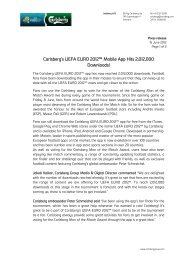
![[Name and Address] - Carlsberg Group](https://img.yumpu.com/49766377/1/184x260/name-and-address-carlsberg-group.jpg?quality=85)

![[Name and Address] - Carlsberg Group](https://img.yumpu.com/49015962/1/184x260/name-and-address-carlsberg-group.jpg?quality=85)
